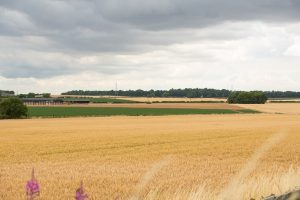The Farm
farm@leeds.ac.uk
0113 343 7996
Not applicable
Calendar

Leeds Farm Atmospheric Observatory
As a service to the wider community, the AMOF website “showcases” facilities that are not operated or supported by AMOF.
This is not an AMOF Observatory please do not apply to AMOF for access.
The Leeds Farm Atmospheric Observatory
The Leeds Farm Atmospheric Observatory is located on the University of Leeds Research Farm.
This is a working arable farm; an instrumented site for the earth, atmosphere and agricultural observation; and the site of the National Pig Centre (NPC), which is the UK’s largest and most advanced facility for research into pig nutrition, behaviour, welfare & health, and production systems.
Location
The farm is located between Leeds and York, covering approximately 317 hectares, bringing together four farmsteads.
Currently, about 75% of the land is used for arable farming, including wheat, barley and oilseed rape. There are smaller plots used for potatoes and peas. A small number of agroforestry plots are located across the farm, covering 7.7 hectares.
Average temperatures range from a low of 4°C in January to a high of 16°C in August, with an annual average temperature of 9°C. The average minimum daily temperature between December and February is below freezing.
The site’s elevation ranges from 42 to 70 metres above sea level.
Soils are typically shallow (less than 50cm deep across large areas) well-drained, calcareous, fine loamy soils (Aberford Series) lying above a dolostone aquifer of the Cadeby Formation.
The climate is typical of the region. Due to its position in the rain shadow of the Pennines, the site has a relatively low annual rainfall, mild winters and cool summers.
The annual average rainfall is 674mm, with August being the wettest month (65.9mm) and February the driest (46mm).
The Instrumentation
The University of Leeds Research Farm implements state-of-art field instrumentation for intensive, integrated Earth and agricultural observation and experimentation at the land surface. The instrumentation extends from the below-ground bedrock, through groundwater, the soil and vegetation cover to the atmospheric boundary layer.
The development of the site is an ongoing process with new instrumentation and facilities being added all the time.
The farm links the following observing and experimentation systems:
1. Dynamic water budget including soil, groundwater, pollution and lysimeter manipulations.
2. Tracking vegetation dynamics including crops and biodiversity.
3. Weather dynamics and land-atmosphere exchange of Greenhouse gases, water and aerosols.
4. Atmospheric chemistry and physics and interaction with vegetation and land surface.
5. Precision crop/livestock agriculture with GPS, imaging, AI and robotics.
6. Manipulating plants/soil in a rhizotron root observatory and free-air CO2 enrichment.
7. Tracing food through the supply chain to consumers and resource recovery.
8. Integration of land and remote data streams for analytics and computer simulation.
Leeds Farm Atmospheric Observatory
The planned (completed 2022/23) Leeds Farms Atmospheric Observatory comprises two sites within the Leeds farms.
The main compound is sited in a field behind Wise Warren Farm. This relatively large site will be surrounded by hedgerows (some new) and has a surface of Grasscrete. It will have a landing base for drones.
A smaller compound, located in a more open area at Headley Hall farm, to site equipment that needs to have clearer horizontal sightlines in order to function correctly.
Both compounds host several shipping containers of equipment and smaller items of ground-mounted equipment used to measure atmospheric conditions in the farms.
The farm is also the site of the region Met Office weather station and the Centre of Ecology and Hydrology (CEH) COSMOS – UK (Cosmic Ray Soil Moisture Monitoring Network) site, which is collocated on the farm.
The Met Office Weather station is a standard set-up, which includes atmospheric pressure, air temperature and humidity, wind speed and direction and precipitation. In addition, the COSMOS-UK site includes net radiation (incoming and outgoing long and short-wave radiation), potential evaporation, daily mean albedo, soil moisture content at multiple depths (5-50cm) and soil temperature profiles at multiple depths (2-50cm).
You can view the live data from the site on the UK Centre of Ecology and Hydrology website.
There are currently 3 flux towers situated in multiple fields across the site measuring the vertical exchange of CO2, and water between the soil and atmosphere. These are supported by Modular hyprop and KSAT systems, water potential sensors and soil moisture sensors.
A series of gas collars at the land surface can be installed across the fields or with the Lysimeter to allow direct chamber measurement of GHG emissions using a portable analyser at experiment sites.
 Contact and further information
Contact and further information
To collaborate with us or use the University of Leeds Research farm in a project or field trial email the Farm.
Visit the Global Food and Environment Institute website for more information about the current research happening at the farm site.
Visit our 3D Farm website, which gives the opportunity to virtually walk around the site of the farm.
